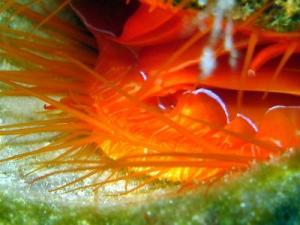Jun 25 2014
Four years after falling in love with the disco clam – a cute little mollusk known for its underwater light show – Lindsey Dougherty has discovered the secret of its mirrored lips.
 The disco or electric clam, Ctenoides ales, continually flashes light along the lip margins of its mantle. UC Berkeley graduate student Lindsey Dougherty discovered that the mirrored lips are composed of packed nanospheres ideal for reflecting the blue light prevalent underwater. Credit: Lindsey Dougherty, UC Berkeley
The disco or electric clam, Ctenoides ales, continually flashes light along the lip margins of its mantle. UC Berkeley graduate student Lindsey Dougherty discovered that the mirrored lips are composed of packed nanospheres ideal for reflecting the blue light prevalent underwater. Credit: Lindsey Dougherty, UC Berkeley
A dive instructor and University of California, Berkeley, graduate student, Dougherty first encountered the two-inch clam in 2010 while diving with her mother and sister in Wakatobi, Indonesia. She and her sister even did a bit of underwater disco dancing to the clam's flashing beat.
"I've dived with humpback whales and great white sharks," said Dougherty, who first learned to dive at age 14 and taught diving in Zanzibar. "But when I saw the disco clam, I was enamored. I said then, 'I'm going to do a Ph.D. on the disco clam.'"
It didn't take long for her to confirm that the flashing was not, as most people assumed, a form of bioluminescence – a chemical reaction inside animals like plankton that produces light similar to that of a glow stick. Instead, she found, the edge of the clam's mantle lip is highly reflective on one side. When the clam unfurls its lip – typically twice a second – the millimeter-wide mirror is revealed and reflects the ambient light, like a disco ball.
In this week's issue of the British Journal of the Royal Society Interface, Dougherty reports the unusual and perhaps unique structure of this mirrored lip.
The inside of the clam's lip is packed with tiny spheres of silica, only 340 nanometers in diameter, that are ideal reflectors, particularly of the blue light that penetrates deeper into seawater than does red light. The outside of the lip contains no silica nanospheres, so when the lip is furled, no light is reflected.
By repeatedly unfurling and furling the lip, the clam produces a continual rippling light show. The non-reflective back of the lip strongly absorbs blue light, so it appears dark and makes the contrast between the sides even more striking.
Dougherty used high speed video, transmission electron microscopy, spectrometry, energy dispersive x-ray spectroscopy and computer modeling to study the detailed internal structure of the margin of the clam's lip. She was assisted by colleagues Roy Caldwell, UC Berkeley professor of integrative biology; Sönke Johnsen of Duke University; and N. Justin Marshall of the University of Queensland, Brisbane, Australia. She could find no other instance of animals using silica nanospheres as flashing reflectors, though the white color of several insects apparently comes from a layer of silica that reflects white light.
The big question, Dougherty said, is why the clam flashes at all.
Called Ctenoides ales and sometimes referred to as the electric clam, disco clams are found in tropical areas of the Pacific Ocean, living in crevices in reefs and typically in clusters of two or more. Light is dim and blue-green at the clams' typical depth, which ranges from 3 to 50 meters (10-150 feet), but their rippling mirrored lips are visible even without artificial illumination. Dougherty said the question she is exploring is whether the clam is trying to attract prey, mostly plankton, or other clams and potential breeding partners; or if it is trying to scare away predators.
In ongoing experiments in Caldwell's lab, she is studying the structure of the clam's eyes – all 40 of them – to see whether they can even see the disco light. She also is raising clams in tanks to determine if they signal one another visually or chemically, and is testing their responses to fake predators.
The field work was conducted at Lizard Island Research Station in Australia and the Raja Ampat Research and Conservation Centre and Lembeh Resort in Indonesia.